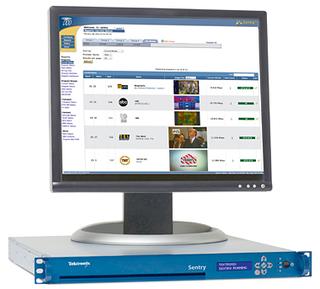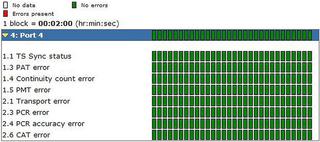Preparing for HEVC, 4K Test and Monitoring

Malateshgouda Karegoudar, Tektronix
ALEXANDRIA, VA.—Significant change is on the way for the entire broadcast ecosystem. In order to accommodate 4K/UHD transmissions, the way in which video is compressed for transport must improve dramatically. The migration from MPEG-2 and AVC/H.264 to HEVC/H.265 will open up new opportunities, but will also come with risks and potential hidden costs that could neutralize the savings in transmission costs.
For many broadcasters, cable operators and other video service providers, the 4K/UHD transition offers a way to differentiate their offerings from the competitors and generate new revenue streams. However, getting to that point will require a dedicated focus to find the right compression encoding schemes, and potentially significant upgrades to Quality of Service and Quality of Experience monitoring, as well as many other infrastructure improvements.
High Efficiency Video Coding (HEVC or H.265) is designed to deliver the same visual quality as Advanced Video Coding (AVC or H.264), while using about half the bandwidth. It supports all current resolutions including 4K and 8K, and will allow content distributors to deliver HD video to mobile devices over mobile data networks at reduced bandwidth costs, as well as enabling delivery of 4K and beyond video to the home. HEVC addresses essentially all existing applications adopting H.264/AVC, while offering higher video resolution and increased use of parallel processing architectures.
Cutting the cost of transport by squeezing the same data into fewer bits can offer savings, but that doesn’t change the fact that 4K streams will raise costs in other areas. For instance, it costs more to ingest, encode, store, protect and transcode more densely compressed HEVC data flows. Although bandwidth is important, it is just a portion of the overall cost of any video workflow.
The big question then is whether making the move to 4K will make sense, not just from a technical perspective, but from a business perspective as well. Some question if 4K will capture the attention of consumers, while the move to HEVC will require that Apple and Android include HEVC support in their devices. Encoders and adaptive bitrate streaming (ABR) software providers, to name a few, need to be onboard as well.
However, there is also a good case to be made for 4K, most notably for its stunning video quality, which always seems to win consumers’ hearts and minds. One organization that sees a first-mover opportunity is DirecTV, which became the first multichannel video provider to offer commercial 4K when it launched a new 4K video-on-demand service in December 2014. DirecTV plans to offer more than 30 UHD titles to its 32 million subscribers in the U.S. and Latin America. Netflix is also offering 4K streaming of some programming, notably its “House of Cards” series.
Get the TV Tech Newsletter
The professional video industry's #1 source for news, trends and product and tech information. Sign up below.
Other signs around 4K are positive as well. ABI Research, for instance, predicts that five percent of televisions in North American will be 4K capable by 2017. That percentage is expected to double by the end of the following year. The ultimate conclusion is that the industry must begin planning for an HEVC and 4K world.

Tektronix Sentry test system
When considering the move to HEVC and 4K, it’s critical to invest in quality monitoring tools. “Pretty good” 4K misses the point: it’s either awesome or not good enough. Consumers who pay a premium for 4K expect a premium product. If a subscriber is paying for 4K and what they receive is the same as HD in the past, there will customer satisfaction issues. As such, the QoE on 4K will be even more critical than it is today.
But the situation isn’t as bad as it might seem. Upgrading systems to deliver UHD images can have benefits in other areas. A system that has been upgraded to monitor 4K quality is better equipped to monitor standard-definition and HD streams. Such system-wide improvements are likely to lead to happier subscribers overall, making the investment more easily justified.
GETTING A HANDLE ON HEVC
Video compression standards, such as HEVC, are complex and involve many elements vitally important to the efficiency and interoperability of compressed video in different applications. Therefore, it is critical to use an analyzer that provides verification of the compliance of the stream against the compression standard, detailed analysis and statistics of the video and audio streams, tools for editing and debugging the stream, fidelity comparison against the original uncompressed stream, and the ability to check for any video and audio delay. This allows video designers and engineers to test compliance, interoperability and performance of various compression products.
Efficient encoders are critical for achieving the projected bitrate reductions for HEVC while maintaining quality. When comparing video encoders, it’s helpful to have statistics from different encoders for the same quality of video, for instance, to see if each of them is producing a compliant bit-stream or if there are buffer violations while decoding that can affect the decoder, among other factors.
HEVC is a block-based codec, consisting of bigger blocks of “coding tree units” (analogous to macroblock) that has their size selected by the encoder. The encoder decides to use larger coding units where there is little or no encoding needed (more compression) and picks smaller coding units where more encoding is needed. The size of coding units can vary from 16, 32 or 64 samples, with large size enabling better compression.
A video frame in HEVC consists of many coding tree units, which in turn is built up from coding units. Any coding tree unit or coding units will have different encoding parameters chosen by the encoder. Analysis tools can provide insight to how the encoder is operating.
For example, a CU-size distribution graph, as shown in Figure 1, indicates the different sizes of CUs chosen by the encoder. In the case of a uniform area of the picture, the higher the size of coding units, the better the compression will be. It is expected that more complex scenes will use smaller CU sizes because they can more efficiently encode fine details compared to the large CU blocks.

Figure 1. An analysis tool like Tektronix MTS4EAV7 provides insight into HEVC encoders, such as how the coding unit size varies for each video frame.
Once it has been determined that the compressed video stream is syntactically and semantically correct (legal according to the HEVC codec standard), the next step is to look at the visual differences between the original video and the decoded HEVC video. There are a number of different methods and algorithms available to complete this task.
The most basic is to simply play the source and decoded video on two different video monitors and ask human viewers to rate any visually differences. This method is highly subjective as each viewer will use his or her own personal preferences to determine video quality. The down side of using real humans is that people can occasionally say that two video clips are slightly different, when in fact they are identical or vice versa.
The best method, when using human viewers, requires a rigidly-controlled viewing room with a large population of human viewers sampled in order to gain valid statistical results. Because of the high cost of such a test, it is not preferred over the use of mathematical models used to determine video quality. The most common models used today include peak signal-to-noise ratio (PSNR), differential mean opinion score (DMOS), and picture quality rating (PQR).
With the move to 4K, more focus will be placed on QoS and QoE than ever before. QoS emphasizes low-level factors related to the physical delivery of bits and whether they arriving on time in the right order. However, good QoS does not necessarily mean that all is well from the viewer’s perspective. QoS can be perfect, but since these tools have no way to look at the packet content, the actual received picture quality can fall short. Figures 2 and 3 provide an example where perfect QoS does not highlight audio and video QoE issues.

Figure 2. Example of an error-free transport stream according to QoS monitoring.

Figure 3. The same transport stream when monitored by QoE shows audio/video missing packets and slice errors.
In the context of 4K, QoE is likely to take center stage. QoE focuses on the creation of metrics and measures that directly impact the viewer’s experience. For the most part, the principles behind QoE will stay the same for UHD as they are today. What is likely to change in terms of QoE is probes—the hardware and software components that are placed throughout the network to measure and monitor QoS and QoE levels.
As networks transition to 4K, it will be important to focus on such factors as how many probes to add, where to put them, and how to program and manage them in a way that produces useful data. At the same time, safeguards need to be put in place to avoid information overload.
Placement of probes is vital. A hit or miss approach is unlikely to be sufficient, given the potential for errors in a highly compressed, high-bit rate data stream. Guidelines like those found in SCTE-168 can be helpful and in theory should apply in an HEVC and 4K environment.
For the most part, these guidelines propose a common-sense approach to probe placement to check parameters that could impact QoE—and to avoid the rest. In particular, it is advisable to concentrate probes at transition points.
A follow-on question is determining the roles of the various probes. QoS is simpler and therefore less of a problem—QoE settings are a different story. One of the important tasks for probes is to ensure that the syntax is correct and not creating image-degrading artifacts. Since probes can be set at any tolerance, it’s important to have enough sensitivity to the data and alarms necessary to protect QoE without so much sensitivity that alarms are being raised for conditions that do not impact QoE.
The importance of ensuring quality might be an indicator that for 4K, it would be best to err on the side of too sensitive, at least initially. The use of probes and monitoring solutions with root-cause analysis software will help to automatically sort through alarms to identify real problems.
The arrival of HEVC, with or without a move to 4K, adds a new dimension to video quality monitoring that must be managed. At the same time, it opens the door to improved service levels and potential for new revenue generating opportunities.
However, that era will only be achieved by paying close attention to QoS and QoE.
Malateshgouda Karegoudar is the product manager and planner for the MPEG video test and measurement group in the video product line at Tektronix.
